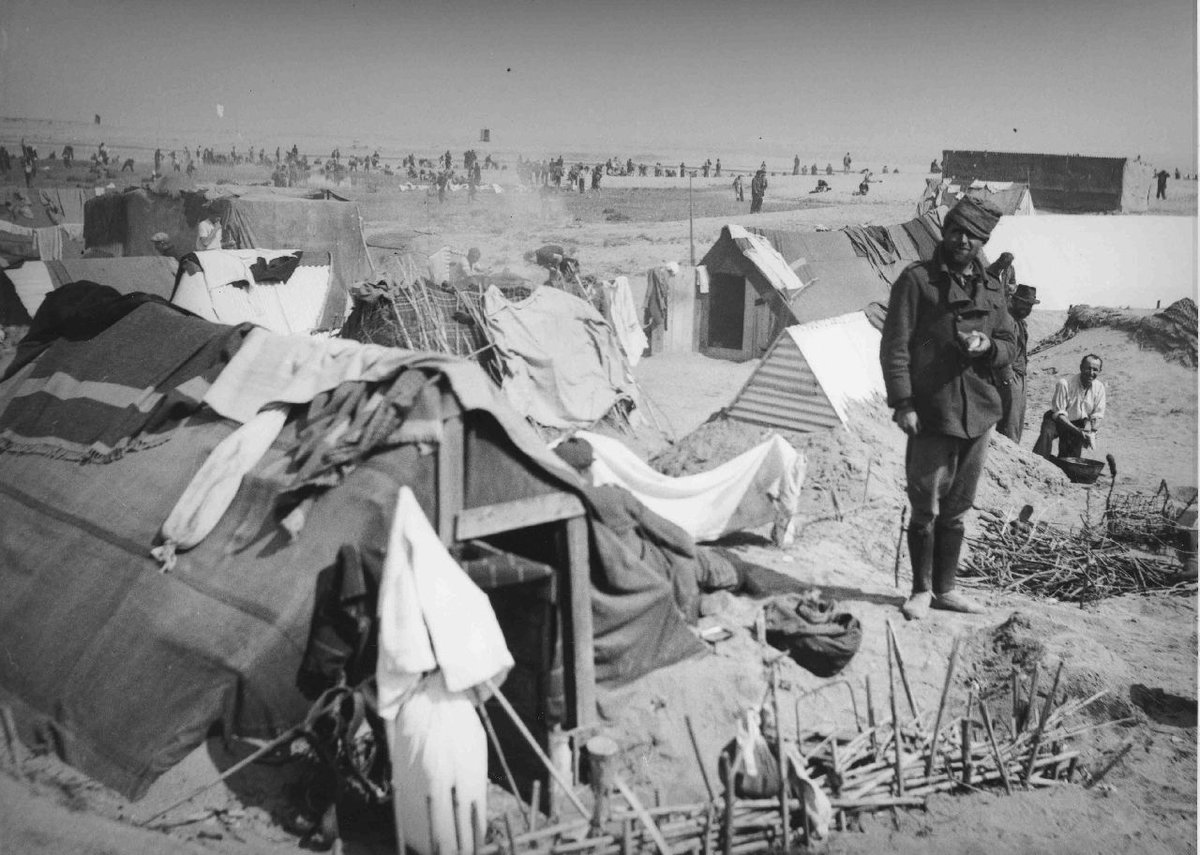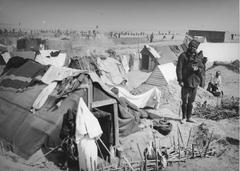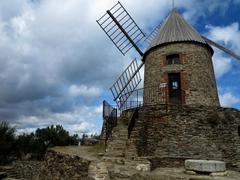
Argelès-sur-Mer Concentration Camp: Visiting Hours, Tickets, and History Guide
Introduction
The Argelès-sur-Mer Concentration Camp memorial is a landmark of remembrance and reflection, located along the Mediterranean coast of southern France near the Spanish border. Established in 1939, it stands as a powerful testament to the suffering and resilience of Spanish Republican refugees who fled the Spanish Civil War during the historic “Retirada.” Today, the site is both a solemn memorial and an educational center, offering visitors a deeper understanding of the humanitarian crisis, displacement, and the ongoing importance of human rights. This comprehensive guide covers the camp’s historical context, practical visitor information, and tips for a meaningful visit (Wikipedia; Mémorial Argelès; European Memories).
Historical Background
Origins and Establishment
The Argelès-sur-Mer camp was constructed in early 1939 as a direct response to “La Retirada,” the mass exodus of over 450,000 Spanish Republicans and civilians fleeing General Franco’s advancing forces at the end of the Spanish Civil War (Wikipedia). The French government, overwhelmed by the influx, hastily converted a stretch of beach at Argelès-sur-Mer into an internment camp, which soon became the largest of several similar camps in the region (Argelès Memorial Camp). At its peak, the camp held as many as 80,000–160,000 refugees, including not only Spanish Republicans but also members of the International Brigades and, later, other groups persecuted during World War II (Tourisme Pyrénées-Orientales).
Life and Conditions
Life in the camp was marked by deprivation and hardship. Refugees arrived exhausted and traumatized, only to find an open stretch of sand with no permanent shelters, limited sanitation, and scarce food or medical care. Many dug holes in the sand for shelter, and disease, exposure, and malnutrition were rampant (European Memories). The camp’s bleak conditions are now central to its legacy, serving as a stark warning about the consequences of war and forced displacement.
Visiting the Memorial: Hours, Tickets, and Accessibility
Memorial Site and CIDER Visitor Center
-
Memorial Stele and Outdoor Area:
Open 24/7 year-round. This beachfront space, marked by commemorative monuments and panels, is freely accessible to all, without tickets or time restrictions (Mémorial des Nomades de France). -
CIDER (Centre International de Documentation et d’Études de la Retirada):
Located at 26 Avenue de la Libération, 66700 Argelès-sur-Mer, CIDER houses exhibitions and educational resources related to the Retirada and internment camps.- Opening Hours:
- October to June: Tuesday to Saturday, 2:00 pm – 6:00 pm
- July, August, September, and Easter Week: Daily, 10:00 am – 6:00 pm
- Closed on Christmas, New Year’s Day, and early July for maintenance (WhichMuseum)
- Admission: Free entry; no tickets required.
- Contact: +33 468 958 503 | [email protected]
- Opening Hours:
Accessibility
Both the memorial area and CIDER are accessible to visitors with reduced mobility, featuring flat terrain and accessible entrances. Visitors with specific needs are encouraged to contact the site ahead of their visit.
Memorial Features and Educational Resources
Key Memorial Elements
- Memorial Stele and Plaques:
The main memorial stele, installed in 1956, is a prominent site of remembrance. In 2025, a plaque designating it as a “Lugar de Memoria Democrática” (Place of Democratic Memory) was added, recognizing the suffering and democratic ideals of the Spanish Republican exiles (Tiempo de Historia). - Interpretive Panels:
Panels in French, Catalan, and Spanish outline the camp’s history, daily life, and personal testimonies. - Spaniards’ Cemetery:
A burial site for refugees who perished in the camp, accessible along the memorial route. - CIDER:
The interpretation center offers archives, photographs, artifacts, and multimedia presentations, providing deep insight into the historical context (European Memories).
Educational Programs and Guided Tours
- Guided Tours:
Available by request at CIDER, especially for groups and schools. Tours are offered in French, Spanish, and Catalan, with some English resources available. Booking in advance is advised. - Workshops and Temporary Exhibitions:
CIDER regularly hosts exhibitions and educational activities. Check the events calendar for current programming.
Visitor Experience and Recommendations
What to Expect
The memorial is an open-air, contemplative site. While no original camp structures remain, the memorial stele, explanatory panels, and peaceful beachfront setting provide an evocative contrast to the camp’s tragic past. Expect a solemn atmosphere conducive to respectful reflection.
Recommended Duration
Allow 1.5–3 hours for your visit, including time at CIDER for exhibitions and, if possible, participation in a guided tour or workshop.
Annual Commemorative Events
Each February, commemorative ceremonies mark the camp’s opening and the Retirada, featuring speeches, tributes, and cultural events attended by survivors, descendants, and officials (Tiempo de Historia).
Photography and Conduct
Photography is permitted but visitors should remain respectful, particularly during ceremonies or when other visitors are reflecting.
Getting There and Practical Tips
Directions
- By Car:
Argelès-sur-Mer is 25 km south of Perpignan. Parking is available near the beach and town center. - By Train:
Regional trains connect to Perpignan; the memorial is about a 20-minute walk from Argelès-sur-Mer train station. - By Bus/Shuttle:
Local buses and shuttle services operate in summer between the town center and beachfront.
Amenities
- Restrooms: Available along the beachfront and in the town center.
- Dining: Numerous cafés and restaurants nearby offer local Catalan and French cuisine.
- Accommodation: Hotels, guesthouses, and campsites are available throughout Argelès-sur-Mer.
Visitor Tips
- Prepare for outdoor conditions: bring sun protection, water, and suitable clothing.
- Review the history of the Spanish Civil War and the Retirada before your visit to enhance your understanding.
- For a more in-depth experience, participate in a guided tour or workshop at CIDER.
Nearby Attractions
- Other Memorials:
The Rivesaltes Camp Memorial and Gurs Camp offer further insights into the history of exile and internment in southern France. - Natural Sites:
Explore the Mas Larrieu National Nature Reserve or the scenic Pyrenees for a broader regional experience.
Frequently Asked Questions (FAQ)
Q: Is there an entrance fee to visit the Argelès-sur-Mer Concentration Camp Memorial?
A: No, both the outdoor memorial area and CIDER are free and open to the public.
Q: Are guided tours available?
A: Guided tours and educational workshops are available at CIDER by appointment; the outdoor memorial is self-guided.
Q: Is the site accessible for visitors with reduced mobility?
A: Yes, both the memorial and CIDER are wheelchair accessible.
Q: When are commemorative events held?
A: Major commemorations take place each February to mark the Retirada and the camp’s opening.
Q: Can I take photographs?
A: Photography is generally permitted; please be respectful, especially during ceremonies.
Summary and Final Recommendations
The Argelès-sur-Mer Concentration Camp memorial is an essential destination for understanding the impact of war, forced migration, and the resilience of those who endured exile. Through its commemorative stele, educational exhibitions, and annual events, the site honors the memory of Spanish Republicans and others interned during World War II. Visitors of all backgrounds are encouraged to engage thoughtfully with the site, participate in guided activities, and explore related regional history. For more details, consult the official memorial website, the local tourism office, or download the Audiala app for interactive guides and updates.
References and Further Reading
- Wikipedia: Argelès-sur-Mer concentration camp
- Mémorial du camp d’Argelès-sur-Mer Official Site
- European Memories: Argelès-sur-Mer Memorial
- Tourisme Pyrénées-Orientales: Argelès-sur-Mer Memorial
- Argelès-sur-Mer Memorial Visiting Hours & Historical Site Guide
- Mémorial des Nomades de France: Argelès-sur-Mer Camp
- Tiempo de Historia: Argelès-sur-Mer Designated Place of Democratic Memory

